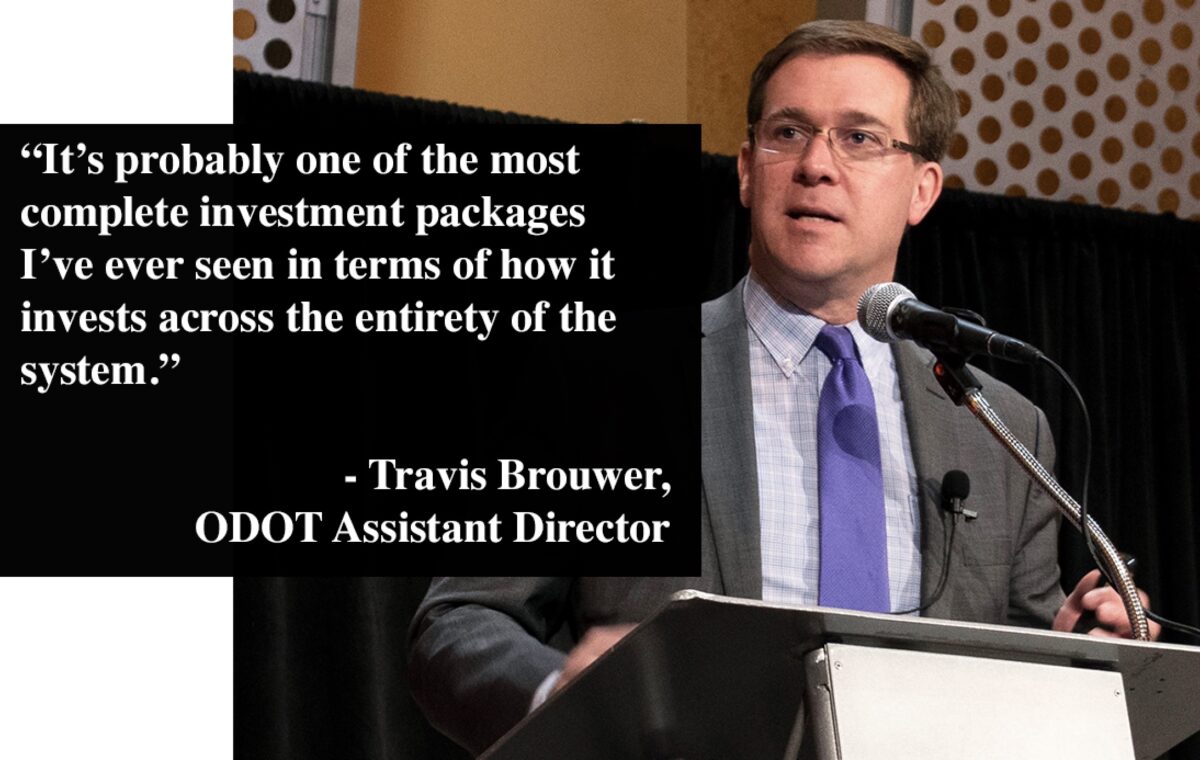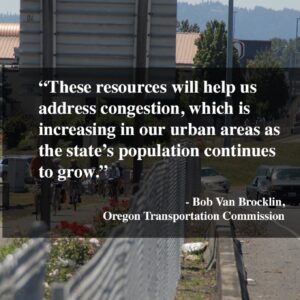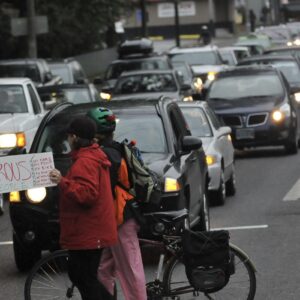In our ongoing effort to understand what the Biden infrastructure package means to Oregon, I recently had a conversation with Oregon Department of Transportation Assistant Director of Revenue, Finance, and Compliance Travis Brouwer.
The interview below has been edited for brevity and clarity…
Can you put this new funding into context?
“This funding will be a substantial increase in federal dollars coming into Oregon and really for the first time in about 15 years that we’ve seen additional federal resources come in in any substantial way for any sustained amount of time. I was looking at the numbers earlier today, and normally over a five year period, we would expect that Oregon would get about $3.3 billion dollars in funding for highways and transit and active transportation and the safety programs. As a result of this bill will get an extra $1.2 billion over that five years that this Infrastructure Investment and Jobs Act covers. That’s more than a one-third increase, so a pretty substantial increase in federal funding.
But to put it into context, when you look at this, you know, about $1.2 billion in additional funding over a five-year period. You’re talking about a quarter billion dollars a year in additional funding. The HB 2017 package that was passed by the legislature four years ago, was more like $600 million a year in additional funding. So while this is going to be really, really helpful in making some substantial investments, it’s still about half of what we received in legislative funding from the state several years ago.”
I realize there was an expectation within ODOT this was going to pass and I saw that you told OPB the agency has already been doing a lot of thinking about how to spend the funds. Can you help us understand more about the agency’s thinking at this point in time?
“A lot of the money comes with with strings attached. There’s pretty specific direction from Congress about how to spend about two-thirds of the dollars that will come in the door. So for example, you probably saw there’s about a quarter-billion dollars for bridges. There’s a lot of money that will go into local governments, we’re estimating that that will be a total of well over $200 million when all is said and done. There’s $200 million for public transportation. But after all of those specific program areas are set aside, about two-thirds of that money, you have about a third of it that’s flexible funding that is really up to the Oregon Transportation Commission (OTC) on how to spend it. And so they’re going to be going through a similar process to what we went through just a year ago with the Statewide Transportation Improvement Program (STIP), figuring out what’s the best way to spend that money across different categories — things like our “Fix it” programs that preserve bridges and pavement, our public and active transportation programs that provide greater transportation options, or what we call our “Enhance” highway programs that add capacity to roads, fix interchanges, add lanes here and there.
They’re going to be looking at how can we best spend this these flexible dollars in order to try to achieve the goals that we’ve laid out in our Strategic Action Plan and are laid out and other statewide policies. So that’s going to be a process over the next several months that’s going to play out and we’re going to get substantial input from the public, from stakeholders, from the advisory committees that we’ve set up — whether that’s our Area Commissions on Transportation (ACTs) that exists all over the state, or whether it’s groups like the Oregon Bicycle Pedestrian Advisory Committee. It’s going to be a very engaged process over the next several months and we expect we’re going to get a lot of input.”
Advertisement
Many people see “highways” as getting the vast majority of funding in this package. And as you know, climate change is a big issue. So when folks see $1 billion for highways they think that’s just going to be a bunch of new freeways. When ODOT refers to “highways” as a spending category, what does that actually mean? How’s that money likely to be spent?
“When we say highways what we really mean is that’s just the money that flows from the Federal Highway Administration. It’s called the Highway Program. And really, a lot of that is flexible and our priority is to look at not just spending on expanding highways. In fact, most of the money that we get goes into basic preservation of keeping our bridges, our pavements, our culverts, or other assets in the state of good repair. And then we made substantial investments in public transportation in the last process of allocating funding in the STIP. The commission put an additional $100 million dollars into public and active transportation in order to achieve some of those goals we have in our Strategic Action Plan around equity for all users around safety for folks who are biking and walking, around providing those multimodal options, and also addressing our climate goals. You’ve seen some pretty substantial increases in investment in that category of public and active transportation. So when we say “highways” it’s certainly a lot broader than that, it just happens to be the formal title of that portion of the bill.”
I hear you that “highway” funds can be spent on things that don’t increase driving capacity, but then again, ODOT doesn’t have the best track record on that. And ODOT has admitted it has a “trust deficit” in the community and there’s some people that I’ve already talked to are really just nervous that ODOT would be given this much money to spend and folks are concerned that the OTC is going to just fall back into the status quo of doing things like expanding freeways and maintaining the interstate system that increases capacity for driving. What would you tell someone with that concern?
“I guess my response would be that the Transportation Commission is ultimately going to be responsible for approving how this funding is spent. They’re going to go through a rigorous process of listening to the public concerns from all sides, from advisory committees, from stakeholders, and then ultimately will make decisions that they believe best align with the state’s goals in transportation. So I guess I would point to, you know, the last process when we went through this similar effort for the projects in the 2025-2027 STIP. The largest category of funding is always preserving the system. We have 8,000 miles of highways and 2,800 bridges and we need to keep them in a state of good repair. That’s always a top priority for the public. So that was the single largest funding area. But you know, second was public transportation, where the Commission put an extra $100 million dollars in funding, even in a process that had less money to go out they put more money into that category… So you know, I guess the proof is in the pudding in the end, and in this last round the Commission showed that they had a strong interest in in investing funding in public transportation.”
Right, but so far transportation emissions are going the wrong direction in Oregon, and the fatality rate is going in the wrong direction. So that’s been the status quo at ODOT. How confident are you that with this new money there’s going to be an opportunity to change that status quo?
“I do think there are a lot of opportunities. If you look at just the money as it comes in, in the bill, you know, about a third of the money right up front goes into sustainable transportation, whether that’s transit and public transportation or active transportation, or the carbon reduction program or the electric vehicle charging. So a substantial portion the money that comes to Oregon, regardless of how the OTC decides to distribute, it will go straight into sustainable transportation. And that will provide a lot of opportunities to do good things out there that can help address our climate commitments, improve the equity outcomes of the transportation system, and really provide a lot more multimodal options. And then beyond that, the OTC’s action plan that is guiding the commission’s work and guiding ODOT has really put, you know, multimodal accessibility and climate and equity as top priorities for the agency. So those will be lenses through which we look at how to spend all this money. Now that doesn’t mean that every dollar of flexible funding will go into those programs because there is still a substantial amount of funding needed to preserve the roads that we have today. But certainly those are going to be top priorities for the agency and the Commission.”
ODOT has recently completed an Active Transportation Needs Inventory (ATNI). How does that play into this new funding?
“Yeah, absolutely. That’s been really important. Our Public Transportation Division, and our active transportation folks as well have been working hard on that, and they use it as a screening criteria. They also have an equity index that they apply as part of that and so we will be using that needs inventory as the Commission lays out the funding for active transportation to help us select projects and to look for where we need to make those key investments. So that’s been really important for us to help us pick the best projects out there.”
On that note of picking the best projects, if we put aside all the public process and the lobbying and advocacy that’s sure to come, is there a policy already baked into ODOT that requires some sort of climate change metric to be applied to project selection?
“Yeah, absolutely. The Governor’s Executive Order 20-04 gave us direction on how to apply climate considerations across our programs. And so we apply it at the front-end, as we’re allocating funding among different potential uses. So when we are taking the different options to the Commission for how they could spend funds, we will apply a climate lens to that as well as other ones that are laid out in our Strategic Action Plan. So we’ll apply those lenses and be able to provide the Commission a sense of how each different funding scenario that we lay out, what impact those outcomes are trying to achieve… Ultimately, as we’re selecting projects, and not just in a sustainable modes, but also general projects across the spectrum, we will be looking at how those projects may impact climate and equity. So when there’s a project that has, you know, a substantial benefit from a climate or equity standpoint, it will get extra points in the selection process and may get picked ahead of something else that doesn’t have those benefits.”
Is there is there anything else you think people should flag and pay attention to with all this as we move forward?
“You know, I think this is just going to be a great opportunity across the entirety of the transportation system. Whether that’s in state highways or local roads, and across all the different modes of transportation. It’s probably one of the most complete investment packages I’ve ever seen in terms of how it invests across the entirety of the system. In the past, we’ve seen some programs that are not as diverse and strong in that regard, they put more money into highways. This one has as a little bit of everything. The discretionary grants, there’s a lot of money for passenger rail, that we’re going to be looking at how can we position ourselves in Oregon or Washington to try to improve service on the Cascades Amtrak corridor that runs from Eugene up into Portland and then all the way up into Seattle and British Columbia. So that could be another great opportunity for us to get some federal investment in that corridor. So, you know, we’ve been really looking across all these different modes of transportation electrification, certainly something of great interest to us. We’ve been working on electric vehicle charging stations, but certainly, electrification is much broader than that. It includes e-bikes as well. That’s a huge growth area in recent years, where we see more and more people who are able to use a bike because they can hop on one that has a little bit of an electric assist. So we’re going to be looking at whether there are opportunities there. Same for their TriMet and other transit districts are really looking at how can they electrify their fleet to get rid of those dirty diesel buses that oftentimes are belching exhaust. Anyone who’s ever ridden a bike behind a diesel bus can tell you it’s not a whole heck of a lot of fun.”






Thanks for reading.
BikePortland has served this community with independent community journalism since 2005. We rely on subscriptions from readers like you to survive. Your financial support is vital in keeping this valuable resource alive and well.
Please subscribe today to strengthen and expand our work.
can we use any of this money to get dirty diesel trucks off the road? air quality benefits would pay for themselves in reduced heart attacks, asthma and other ailments
Yes and no. Some of this money will buy electric trucks for gov’t fleets I’m sure and/or encourage their use. But mostly, dirty diesel trucks is more of an Oregon DEQ thing and less of an ODOT thing AFAIK.
They’re actually more a federal thing; DEQ has almost no say over diesel trucks. We can adopt CA standards (stricter), or the federal ones (what we’ve got), and the legislature controls that decision.
Surprised we’re not part of a CA-OR-WA coordination on that, as in other “west coast” policies. Would be great to see stricter emissions standards up and down I-5.
Yes. I’ve heard that when CA implemented their stricter diesel rules, many of the newly illegal diesel trucks made their way to Oregon and adjacent states. May be a rumor, but sounds about right.
Great questions, Jonathan. Unfortunately, the answers sound a bit hollow. With your previous article revealing that an OTC member sees this as funding to “help us address congestion”, it’s pretty clear the money won’t be allocated to counteract climate change – just more of the same.
Thanks for the interview. The proof is indeed in the pudding. A $5B widening around the I-5 bridge, $1B for the Rose Quarter expansion, $700M to expand I-205, $500M to expand Boones Bridge, $500M for auxiliary lanes throughout the region. Funny, none of those projects have been evaluated around a climate lens.
https://www.oregon.gov/odot/Get-Involved/OTCSupportMaterials/Agenda_F1_UMO_Update_PPT.pdf
The key thing to remember is that almost none of this funding is in the 24-27 STIP that ODOT highlights as an example of how much they’re funding active transportation. It is technically true that the STIP gave a much greater percentage to active transportation than previous years, but the Rose Quarter widening money and other projects aren’t funded by that. ODOT claims (correctly) that the legislature funded them through appropriation, but it’s extremely misleading when your major expansion projects aren’t funded through the STIP process and you claim that the STIP is dedicating historic funding to active transportation.
So an entrenched ODOT staffer says it’s “a great opportunity across the entirety of the transportation system” — that’s all well and good but let’s remember that ODOT has demonstrated it doesn’t really consider cyclists or pedestrians a part of their “system.” If this guy thinks it’s a good plan, then… condolences to rest of us humans.
Can’t wait for a widened covered I-5 from this windfall of cash. Less idling (less pollution) and a great walkable and bikable community will be created (on top of the cars). Realize that may be controversial on this forum but it’s not outside of this group.
This is controversial because it’s wrong.